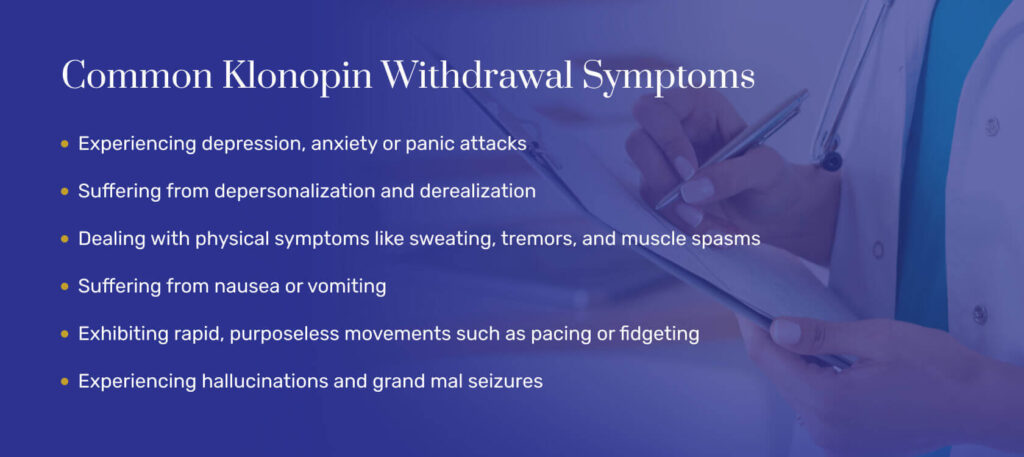Are you or someone you know struggling with addiction?
I may have a problem I am concerned for a loved oneKlonopin withdrawal symptoms can vary considerably and could potentially be life-threatening if the person has severe dependence. Some acute withdrawal symptoms include anxiety, heart palpitations, tremors, sweating, insomnia, hallucinations, and seizures. [1],[2] Because Klonopin is a long-acting benzodiazepine, withdrawal symptoms may not appear for a week after last use and will last three to four weeks.[2]
If you take Klonopin for a medical reason and take it as prescribed, you may develop dependence but it will be mild. Your doctor will create a tapering schedule for you to slowly wean off of it. On the other hand, if you misuse Klonopin to get high, dependence will develop faster and become more severe, resulting in more intense withdrawal symptoms. This is especially true for those with a Klonopin addiction.
How Do You Get Off Klonopin Without Withdrawal?
Quick Answer
The best way to get off Klonopin without experiencing severe or distressing withdrawal is to enter a medical detox program where you will receive 24/7 medical care, supervision, and monitoring. The treatment team will gradually taper you off of Klonopin while providing you with supportive care and counselnig.
What is Klonopin Withdrawal and Why Does it Occur?
Klonopin withdrawal occurs as a result of developing a physical dependence on the drug and then quickly stopping or significantly reducing the amount you are taking. Physiological dependence occurs when the body adapts to the presence of a drug like clonazepam and can no longer function normally without it—the acute withdrawal symptoms are the body’s reaction to no longer having the substance.
While it’s more likely and often more serious if a person regularly misuses Klonopin or similar benzodiazepines, it can also occur after normal, prescribed use.
Klonopin withdrawal can be uncomfortable and long-lasting. It is one reason that you should always talk to a doctor when considering how best to stop taking it.
Klonopin Withdrawal Symptoms
Taking a benzodiazepine like clonazepam for as little as three to six weeks can lead to physiological development—and up to 44% of chronic users experience moderate to severe withdrawal symptoms once they stop taking it.[1]
Quitting Klonopin cold turkey can result in distressing and even potentially life-threatening withdrawal symptoms, such as: [1],[2]
- Rapid pulse
- Anxiety
- Panic attacks
- Depersonalization and derealization
- Depression
- Sweating
- Tremors
- Muscle spasms
- Nausea and vomiting
- Insomnia
- Rapid, purposeless movements like pacing or fidgeting
- Hallucinations
- Grand mal seizures
The most dangerous Klonopin withdrawal symptom is the risk of grand mal seizures, which can be life-threatening. Additionally, hallucinations and psychosis, although not fatal in and of themselves, can lead to irrational or hazardous decisions that put someone’s life at risk. For this reason, the safest setting to withdraw from Klonopin is a medical detox program that offers 24/7 medical care and supervision.

Protracted Withdrawal
Once acute Klonopin withdrawal has resolved, people may experience protracted withdrawal or post-acute withdrawal symptoms. These can linger for weeks months, or even a year after quitting clonazepam. [1],[3]
These symptoms are fairly common, with about 25% of individuals who quit long-term benzo use experiencing them. These symptoms are not constant—they may come and go or fluctuate in intensity.[1]
Common protracted Klonopin withdrawal symptoms include:[3]
- Generalized anxiety
- Agitated depression
- Obsessive-compulsive symptoms
- Panic attacks
If you were taking Klonopin for anxiety or self-medicating an anxiety disorder with this benzodiazepine, it may be difficult to tell if your symptoms are post-acute withdrawal symptoms or “symptom reemergence”. Symptom reemergence can occur when your pre-Klonopin anxiety symptoms return and remain because of a mental health condition. [3]
The term “symptom rebound” refers to the return of acute Klonopin withdrawal symptoms like insomnia, restlessness, and anxiety. These differ from symptom reemergence because they eventually go away.
How Long Does Klonopin Withdrawal Last?
Klonopin is a long-acting benzodiazepine with a slow onset of action. Its half-life—how long it takes for the drug to be reduced to 50% in the body—is between 18 and 50 hours.[4]
Because it has a longer half-life than many other benzodiazepines, withdrawal symptoms may not appear for about a week after a person stops taking clonazepam.[1]
Klonopin withdrawal symptoms tend to peak in intensity and severity during the second week and tend to decrease and then dissipate within three or four weeks. However, protracted withdrawal symptoms may last for several months.[1]
Klonopin Withdrawal Timeline
| Time Since Last Use | Symptom Intensity | Risk of Complications |
|---|---|---|
| 1 week | Symptoms emerge | High |
| 1-2 weeks | Symptoms peak in intensity | High |
| 2-3 weeks | Acute symptoms begin to improve | Moderate |
| 3-4 weeks | Acute symptoms resolve | Low |
| 1-6 months | Protracted symptoms may linger | Low |
Factors That Affect Withdrawal Severity & Length
Some important factors that can affect the intensity and length of Klonopin withdrawal include the following:
- Length of time you were taking Klonopin
- The amount of Klonopin you regularly took
- Whether you engaged in polydrug use or used Klonopin alone
- Whether you suddenly stopped taking Klonopin or slowly tapered your dosing
- Your physical and mental health
- Whether you were misusing Klonopin or taking it as prescribed
- Method of administration (e.g. injecting)
- Individual physiology, including liver functioning
If you were taking Klonopin for a legitimate medical reason and didn’t misuse it, you likely won’t experience severe withdrawal. Severe and dangerous clonazepam withdrawal is generally associated with: [1],[2]
- Taking extremely high doses
- Taking another benzo with Klonopin
- History of alcohol and drug misuse
- Rapid tapering or stopping cold turkey
- Having a panic disorder
- Intense pre-treatment distress, anxiety, and depression
Detox Options for Clonazepam Withdrawal
If you are addicted to or dependent on clonazepam, quitting cold turkey can be potentially fatal—and even if you don’t experience dangerous symptoms, it can be extremely unpleasant and distressing. The two most common ways to quit taking Klonopin are to taper off it gradually with your doctor’s supervision or to enter a medical detox program.[5]
Tapering Schedule
If you were taking Klonopin for anxiety or insomnia and want to quit, talk to your doctor. They will create a tapering schedule for you based on your current dose and how long you’ve been taking this anxiety medication. With this schedule, you will slowly decrease the amount of Klonopin you’re taking so your body can adjust to lowered doses over an extended period of time. This can help prevent the emergence of intense or dangerous symptoms like psychosis or seizures, though the risk is low with someone who is taking it medically.
Every doctor may go about tapering a little bit differently. However, research has revealed some best practices.[6]
Sample Klonopin Tapering Schedule for 3mg
| Week | Dose |
|---|---|
| 2 weeks | 2.5mg |
| 4 weeks | 2.0mg |
| 6 weeks | 1.5mg |
| 8 weeks | 1.0mg |
| 9 weeks | .75mg |
| 10 weeks | .50mg |
| 11 weeks | .25mg |
| 12 weeks | 0.0mg |
Medical Detox Treatment
If you have been misusing Klonopin or are struggling with an addiction to this benzo, medical detox is the safest setting for withdrawal management. Medical detox occurs in a hospital or a freestanding detox center with medical services. You receive around-the-clock monitoring, supervision, and medical care to prevent complications, treat Klonopin withdrawal symptoms, and address any medical emergencies that may occur.
During medical detox, you’ll receive many interventions, such as:[7]
- Symptomatic medications
- Anti-seizure medications, such as valproate
- Supportive care, like IV fluids
- Detox counseling
- Case management and wraparound services
Once you are medically stabilized and have gone through Klonopin withdrawal, the treatment team will help you transition into a comprehensive addiction treatment program so you don’t have a lapse in care. A Klonopin rehab program, such as our addiction treatment center in Pompano Beach, can help you understand the factors that caused your clonazepam misuse, develop adaptive coping skills, address any co-occurring mental health conditions, create a relapse prevention plan, and more.
- Benzodiazepine Dependence and its Treatment With Low Dose Flumazenil. (November 2012). British Journal of Clinical Pharmacology.
- Diagnostic and statistical manual of mental disorders (5th ed.). American Psychiatric Association. (2013).
- Substance Abuse Treatment Advisory. (July 2010). Substance Abuse and Mental Health Services Administration.
- Clonazepam as Agonist Substitution Treatment for Benzodiazepine Dependence: A Case Report Angelo Giovanni Icro Maremmani, Luca Rovai, Fabio Rugani, Silvia Bacciardi, Matteo Pacini, Liliana Dell'Osso, Icro Maremmani. Case Reports in Psychiatry, vol. 2013, Article ID 367594, 4 pages, 2013.
- Management of benzodiazepine misuse and dependence. Brett, J., & Murnion, B. (2015). Australian prescriber, 38(5), 152–155.
- Tapering clonazepam in patients with panic disorder after at least 3 years of treatment. Nardi, A. E., Freire, R. C., Valença, A. M., Amrein, R., de Cerqueira, A. C., Lopes, F. L., Nascimento, I., Mezzasalma, M. A., Veras, A. B., Sardinha, A., de Carvalho, M. R., da Costa, R. T., Levitan, M. N., de-Melo-Neto, V. L., Soares-Filho, G. L., & Versiani, M. (2010). Journal of clinical psychopharmacology, 30(3), 290–293.
- High-Dose Benzodiazepine Dependence: A Qualitative Study of Patients’ Perception on Cessation and Withdrawal. (May 2015). BMC Psychiatry.
















